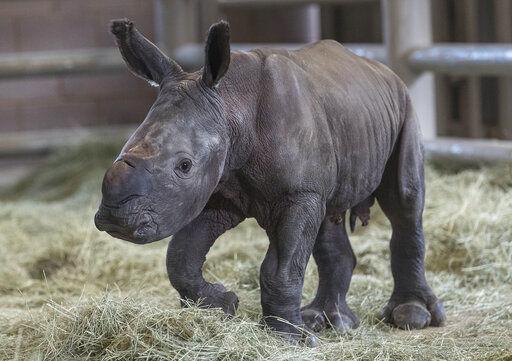
Some rhinos in human care don’t reproduce well, which complicates efforts to sustain these important insurance populations. Scientists have worked for years to develop reliable means of artificial reproduction, with limited success.
Examples are scarce: A dozen years ago, a southern white rhino was born through artificial insemination in Budapest, and a greater one-horned rhino was born with such help in Miami in April.
Southern white rhinos of Africa, once close to extinction, have rebounded in protected sanctuaries. Edward’s arrival by artificial means thus would not have been quite the heralded event it was if not for one fact: His birth holds out hope for saving the functionally extinct northern white rhino.
Only two northern white rhinos remain in the world, and both are female. The last male died in March 2018. The duo lives under protective guard from poachers at the Ol Pejeta Conservancy in Kenya. But there is hope, in the form of DNA from a dozen northern white rhinos banked at the San Diego Zoo Institute for Conservation Research, in a facility called the Frozen Zoo. Over the past 44 years, tissues and cells from some of the world’s most endangered species have been stored in this cryobank.
Analysis by my colleague Oliver Ryder, director of conservation genetics, has found that there is sufficient genetic variability in the frozen northern white rhino cell lines to theoretically reestablish the population. By collaborating with scientists around the world, we envision a future northern white rhino baby born to a southern white rhino surrogate. Perhaps Edward’s mother, Victoria, will fill that role.
Victoria and her new calf are doing well. Edward represents an important step in an effort to save a related white rhino subspecies, but what we learned from his birth could also help Sumatran and Javan rhinos.
At the moment, though, he is simply a baby rhino, staying close to his mother as she guards him, cuddles him (in rhino fashion, between her horns) and puts mud on his back to screen him from the summer sun.
Edward is also a lesson to all of us, a reminder that humans, as stewards of Earth, must protect species at risk of extinction.
The world faces an epic extinction crisis, outlined most recently in a United Nations report in May that brought together three years of work by nearly 150 researchers from 50 nations. Climate change, habitat loss, wildlife trafficking and other human-caused disturbances all play a role in the rising threat.
Humanity must work to preserve these species — in the wild and in managed care. Ideally, protective action will follow the guidelines of the International Union for Conservation of Nature’s One Plan Approach to Conservation, which blends human management with preservation in the wild. But the world cannot wait until each species, one by one, vanishes before our eyes. Success will require initiating conservation efforts when it is possible to bolster and protect existing populations.
Last year, San Diego Zoo Global played a part in efforts to rebuild the black rhino population in Africa by sending a Safari Park-born 8-year-old black rhino to be released into the wild in Tanzania. He has joined a female black rhino at Singita Grumeti Reserves, where we hope they will help restore a rhino population that was lost in the region, and unite four scattered remnant populations of the species.
If they are successful, the species will recover long before it gets to the brink of extinction.
But the northern white rhino is already teetering on the brink. Now we are compelled to intervene using banked frozen cells rather than protecting populations of living individual animals.
Saving individual animals and family groups while fostering sustainable populations is the ideal conservation strategy. But sometimes artificial reproductive intervention may be the only way to avert extinction. With persistence leading to further scientific advances, Edward’s arrival will be living proof of that.